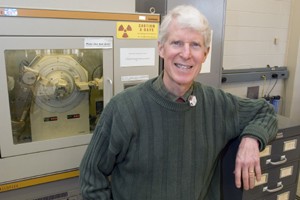
NASA Invites UC s Huff to Advise on Mars Landing Site
Government officials in Washington, D.C., are debating a common dilemma: balancing the needs of scientists with making a public relations splash. But this time, the ground theyre wrestling over is 43 million miles (68 million kilometers) away on Mars.
The Mars Science Laboratory (MSL) is part of NASAs Mars Exploration Program, a long-term effort of robotic exploration of Mars. MSL is designed to ascertain if Mars ever was or is capable of supporting life.
To assist them in making an informed decision, NASA officials have invited a core team of researchers to listen to presentations about the proposed landing sites. UCs Warren Huff, professor of geology in the McMicken College of Arts & Sciences, was asked because of his world-renowned expertise in k-bentonites, a type of clay mineral.
The Pasadena workshop, taking place Oct. 2335, is the second Workshop on Landing Site Selection held by the Landing Site Selection Committee. The goal of this second workshop is to whittle the list of 51 potential sites to the final five candidates. Each of the 51 sites has an advocate to present the benefits of choosing that site.
The natural scientists want a site that optimizes the potential for gathering scientific data, says Huff, smiling. The rocket scientists and engineers would push the envelope to perhaps gave a greater public impact. Our goal is to maximize scientific value with an eye to engineering and public perception issues.

Proposed descent pattern for Mars Rover.
Huff explains that the ideal landing site will have a safe haven, defined by an ellipse that is 20 km in diameter. In that safe haven, its OK no matter where you land it when dropped from a parachute. It should be able to roll over obstacles that are 6070 cm high.
Given that size a safe haven, the team is looking at a wide range of geologic problems.
In some cases the problems the soils; in some its the underlying rock, says Huff.
In his invitation, Huff was told that screening out candidates would be based on the anticipated potential for habitability at the candidate landing sites. A large part of this screen will be based on how mineralogical signatures for certain minerals are interpreted.
What that means is that of concern is not just if its clay, but how did the clay get there? Huff says. On Earth, usually weathering reflects the composition of the parent bedrock. That weathering on Earth is the result of temperature, moisture and winds, for example. Is that the case on Mars?
In southwestern Ohio, the soil-forming process reflects the abundant shales and limestones. At Colorados Pikes Peak, the soil has a high granite content, reflecting the volcanic activity of times past. Scientists are discussing if the soil-forming process on Mars is similar to these examples or if it is the result of a high-temperature hydrothermal process, such as the soil found around the geysers of Yellowstone National Park.
Clays, Huffs specialty area, are also thought to be potential catalysts for early forms of life. Clay minerals form in sheet layers, like phyllo dough. These layers can trap water and act as a template or substrate in the formation of organic molecules, that is, molecules that contain carbon and hydrogen.
Using infrared and reflective spectroscopy, scientists can make measurements of sunlight reflecting off the Martian soil. They see evidence of hydrating minerals containing aluminum, iron, magnesium and silicon, with evidence for bonded hydroxyl ions (containing oxygen and hydrogen).
We see this and say, Aha! Weve got clay minerals there! Huff says. The type of clays is of concern. For example, montmorillonite clay swells when its wet.
People in the Dakotas know not to drive on roads with a lot of clay after a storm, says Huff. Its like driving on toothpaste. Certainly such clays are not an ideal surface for landing an extra terrestrial vehicle, either.
Huff expects that they will look at a handful of scenarios: on one hand is perhaps a site that is high-risk but with high (public) impact potential and on the other hand is perhaps a site that is always a safe bet to land there, but perhaps is a little less exciting. When the Martian dust settles, the folks behind the MSL project hope to have five finalist sites. And Huff?
Itd be cool to get some samples, he says. He is unsure what the role of the advisory committee will be after the meeting, whether they will be asked to continue to participate in the discussion or just make a one-time recommendation. We might just vote and go home, says Huff. Well, Ill be going to Denver!

Mock-up of the Mars Rover.
Related Stories
WVXU: Test your word puzzle skills with a Cincinnati...
April 18, 2024
Cincinnati edition host Lucy May discusses the history and new found popularity of word games with Michael Griffith, professor English. Griffith is a writer, but also develops word games for publication.
Jason and Travis Kelce take Cincinnati to ‘New Heights’
April 16, 2024
UC alumni Jason and Travis Kelce returned to UC for an unforgettable evening that included the Great "Lombaby" Games, a live recording of their podcast "New Heights," special guests Joe Burrow, Orlando Brown Jr. and Desmond Ridder and a surprise commencement ceremony.
UC President Neville Pinto shares 2024 State of the University...
April 16, 2024
University of Cincinnati President Neville G. Pinto shared his 2024 Sate of the University address with the campus community on April 15.
